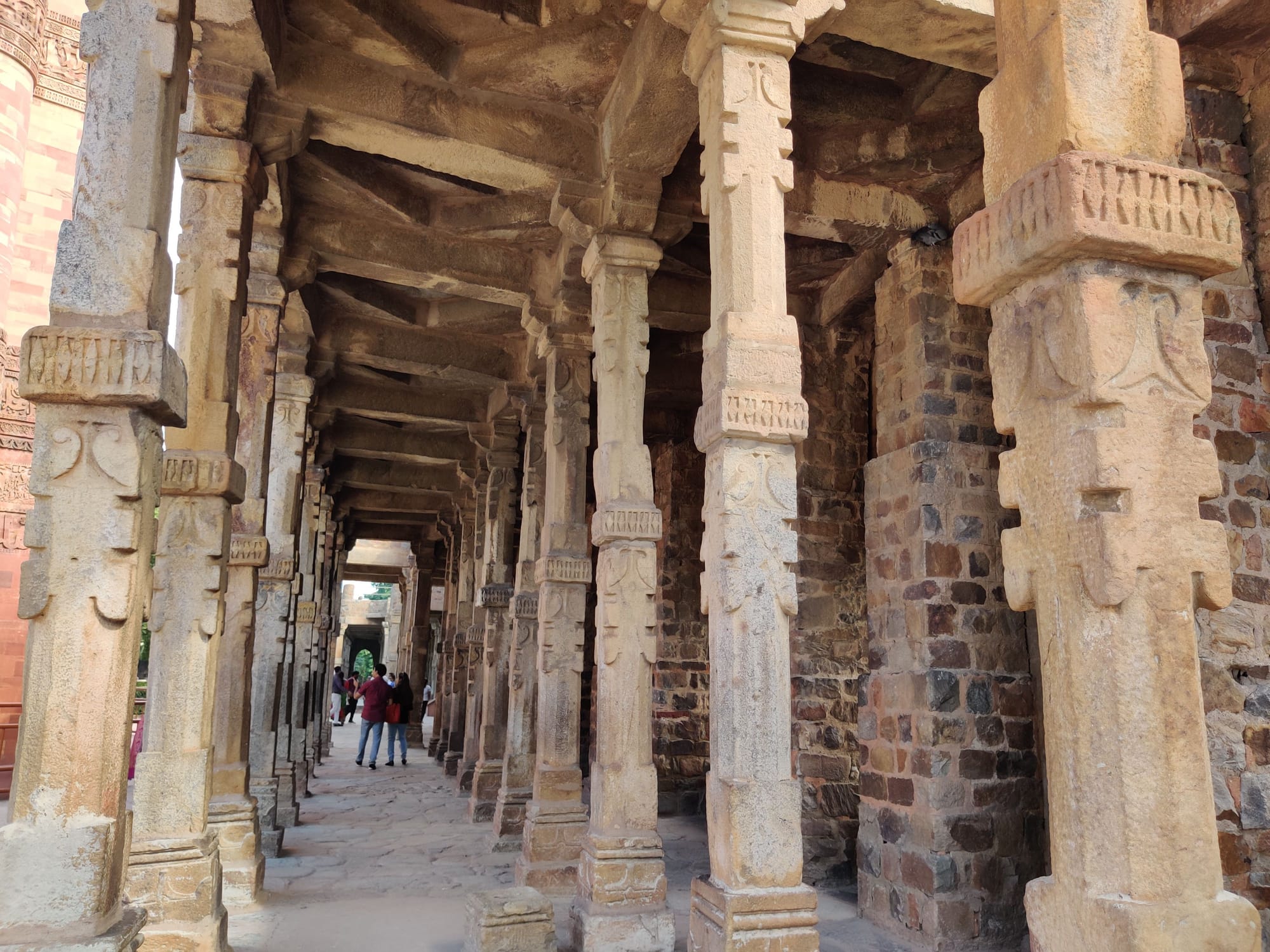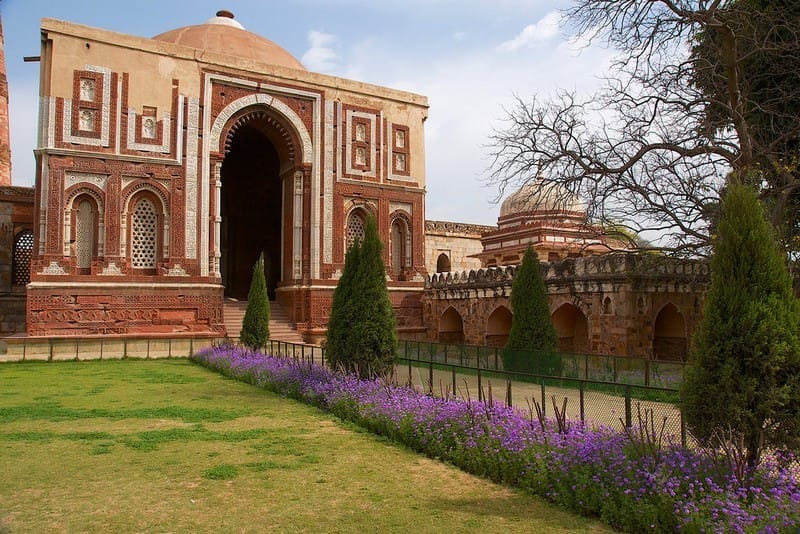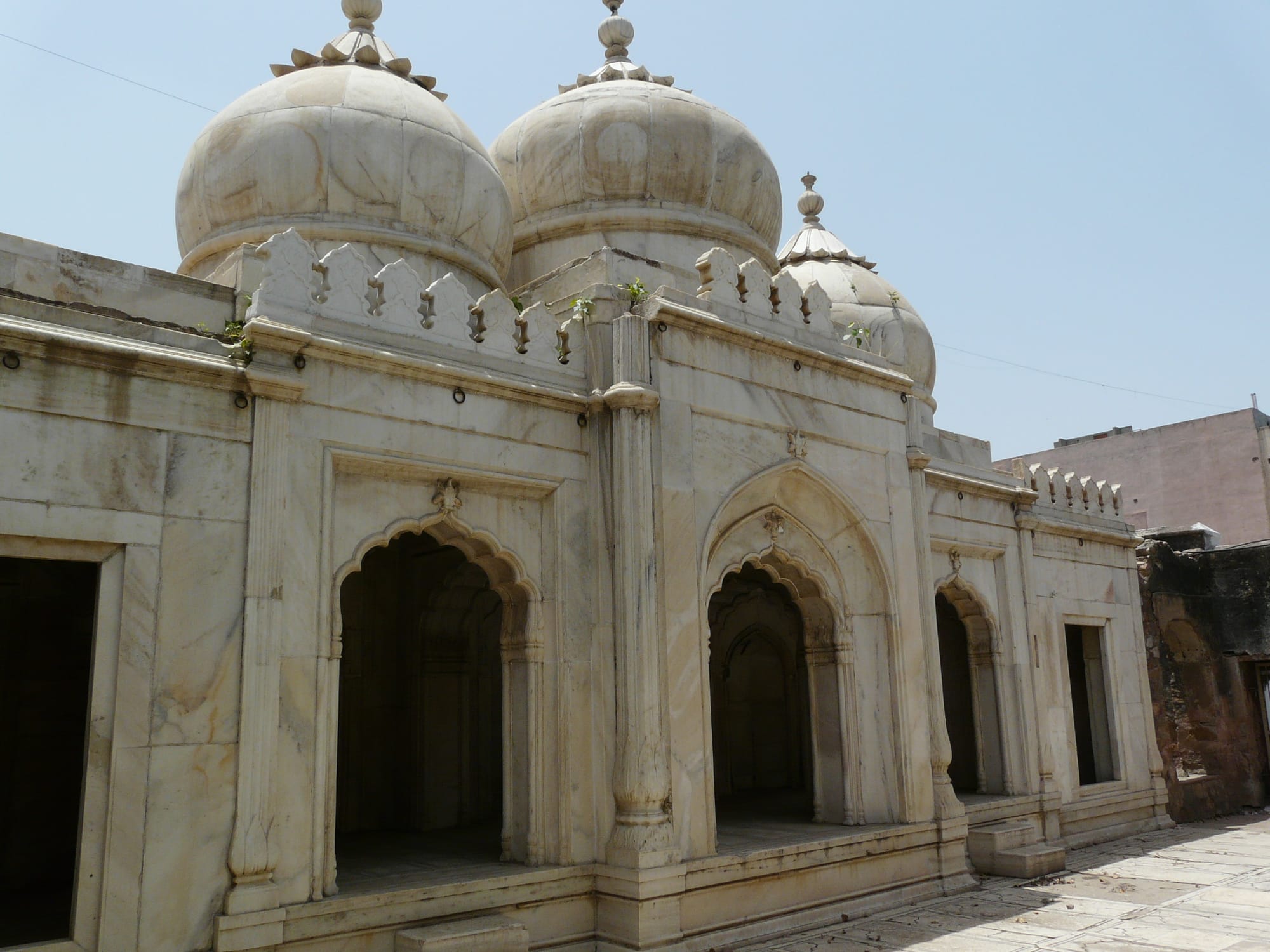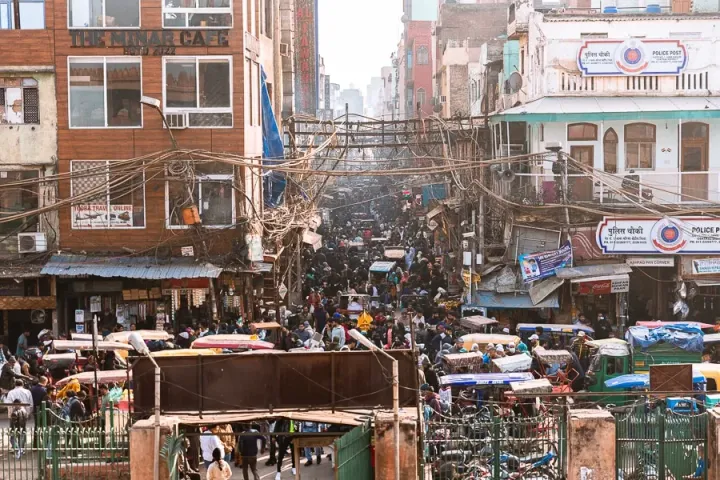Qutub Minar: A Storied Past
The Qutub Minar Complex houses not just the storied Minar but also many other monuments of significance and appeal.

As one stands before the imposing structure of the Qutub Minar, one cannot but be captivated by its grandeur and historical significance. Rising majestically into the Delhi sky, this towering masterpiece remains a testament to the rich tapestry of India's past, weaving together centuries of history, culture, and architectural brilliance.

Origins
Located in the Mehrauli area of Delhi, the Qutub Minar is the tallest brick minaret in the world, standing at an impressive height of 73 meters. Originally, it was meant to be built as a symbol of The Ghurids’ successful conquest. The Ghurids traced their origins to the mountain region of Ghur, located in today’s Afghanistan. Although the Minar’s construction was initiated in 1192 AD by Qutb-ud-din Aibak, the first ruler of the Delhi Sultanate, it was eventually completed by his successor and son-in-law, Shamsuddin Iltutmish. The minaret served as a symbol of victory, commemorating the Muslim conquest of Delhi and the establishment of Islamic rule in the Indian subcontinent.
The Minaret has been said to be inspired by the Minaret of Jam, constructed around a decade before work on the Qutub Minar is said to have begun. The Minaret of Jam built adjacent to the Hari river in Afghanistan is a lot less accessible but like its counterpart, has been declared a World Heritage Site by UNESCO.
The Qutub Complex
However, the Qutub Minar is not a standalone structure. It is situated in the Qutub Complex, which is, in turn, part of Qila Rai Pithora or Lal Kot, the first city of Delhi. Lal Kot was a creation of Anangpal Tomar, the Tomar Rajput king, and its remains can be found in various parts of the southern region of Delhi.
Right at the entrance is a sarai built allegedly by the Mughals in the 1700s as a refuge for travelers who sought shelter. Lush gardens adorn the pathway leading to the Qutub Minar—these are distinctly Mughal in style and known as Charbagh-style gardens designed to mimic the gardens of paradise.
The Quwwat-ul-Islam Mosque translates to "Might of Islam", reflecting its construction's purpose as a symbol of Islamic dominance in the region. The mosque's architecture displays a blend of Islamic and Hindu styles, reflecting the cultural synthesis during this period. Having been set up by Qutub-ud-Aibak in the 1190s, it is one of the first few mosques to have been set up anywhere in India.
The carvings on the mosque include Hindu and Jain elements. At the entrance of the mosque, the Arabic scripts are accompanied by the Kirti Mukha beneath them, an element frequented in the temples of Lord Shiva. Similarly, the pillars of the mosque included carvings of Lord Ganesha. According to an inscription on a pillar towards the eastern gateway, it was built with the leftover remains of 27 desecrated Hindu temples.

The Qutub complex encapsulates a wide array of historically significant architectural features, which also indicate the different visions of those in power at different times.
The Alai Minar was built by Alauddin Khilji, who wanted to leave behind his own personal minar, which he envisioned to be twice as tall as the Qutub Minar. However, he could only ever complete one floor, which is 25 metres tall. Khilji built a madrasa towards the back end of the complex, too, which seemingly has huge classrooms as well as a library. Khilji’s tomb resides in the same building, although that portion has lost the domes littered across the rest of the structure.

The Alai Darwaza, made out of red sandstone and marble, is a main gateaway to the Qutub Minar located towards the south and was built by Khilji in 1310. The slave dynasty used false domes and arches, which makes those on the Alai Darwaza one of the first few true domes and arches in all of India.

Arguably, the biggest tourist attraction in the Qutub Complex, after the minaret itself, is the iron pillar within the complex. A creation during the reign of Chandragupta II Vikramaditya, it was shifted to the complex by Anangpal Tomar. Despite being centuries old, there is not a single speck of rust on the pillar, which is nothing short of a metallurgical marvel.
Qutub Minar and its Many Makers

Coming back to the Qutub Minar is a symbol of Muhammad Ghori’s victory over Delhi. It was built in his honour by his deputy Qutub-ud-din-Aibak. However, like Khilji years later, his reign only oversaw the construction of one storey on the minar. His successor and son-in-law, Iltutmish, built the next three.
Tragedy and lightning struck the minar in 1368, damaging its topmost floor and Firoz Shah Tughlaq took it upon himself to repair the damaged storey and add another one. While the first three, built with red sandstone and marble are a remnant of the Mamluk dynasty, the two storeys on the top are indicative of the distinct architectural style of the Tughlaqs, utilising white marble and sandstone in the construction of the minaret.
Sikander Lodi, in 1503, had his own set of inscriptions carved on the minar when renovation work began after another bout of lightning dealt some additional damage to the minar. A chhatri, designed by Major R. Smith, replaced the Cupola on top in 1802 in the aftermath of the Earthquake, but Lord Hardinge had it removed in 1848. Today, the same chhatri is situated on the outer lawns, famously known as Smith’s Folly.
The variegated architectural features and the different styles and/or purposes of carvings are the most fascinating aspects of Qutub Minar. They reflect its history and its tumultuous journey through the centuries. Over the years, it has stood witness to numerous upheavals, conquests, and renovations, each leaving its mark on the monument. The minaret has survived earthquakes, lightning strikes, and even attempts at demolition, yet it stands tall and proud, a silent guardian of Delhi's past.
From the inside, the minaret is marked by narrow stairs arranged in a spiral pattern that leads to the top of the Minar. However, entry inside the Minar itself has been closed off to tourists indefinitely because of a tragedy that struck in 1981, prompting the Government of India to take drastic measures in the interest of public safety and welfare.
Qutub Minar Timings and Ticket Prices
People can visit Qutub Minar from anywhere between 7 AM to 5 PM. The ideal time to visit Qutub Minar is from anywhere between October to March when the weather is pleasant and temperatures are on the cooler side. The price of tickets for Indian citizens is Rs 35, and for foreign nationals, it's Rs 550. For children below 15 years of age, there are no charges whatsoever.
Food Near Qutub Minar

Qutub Minar at 73 metres tall, is a prominent and towering structure in the area and visible from a great distance. It is not surprising then, that the area nearby has a lot of rooftop establishments from where you can enjoy the serene view market by the magnificent minaret and enjoy delicious food as well. The most well-known restaurant is Bo Thai Qutub, which combines the scenery with some delicious Thai food. Rooh is another such upscale cafe, which serves a fusion of Indian and exotic cuisines. Then there is Shree Shyam Foods which is located right next to Qutub Minar and an affordable restaurant, where the food is bang for the buck.
Transport
Qutub Minar, located in the heart of South Delhi, can be easily accessed by both metro and DTC buses. The Qutub Minar metro station is 1.5 kilometres away from Qutub Minar and auto-rickshaws line up in abundance right outside the gate who would be willing to take you there for as cheap as 50 rupees. The Qutub Minar bus stand on the other hand, is located right next to the Qutub Complex and you would need to catch the following buses to reach there- 34, 334, 356, 413, 427, 463, 493, 502, 505, 525STL, 534, 715, 725.
Other attractions near Qutub Minar
Qila Rai Pithora Fort
Qila Rai Pithora, also known as Lal Kot, is a historic fortification in Delhi, India, dating back to the 12th century. Initially constructed by Chauhan king, Prithviraj Chauhan, it was later expanded by Sultan Muhammad bin Sam of the Slave Dynasty. The fortification encompasses an area of about 6 km and served as the capital of the Delhi Sultanate during the early medieval period. Though largely in ruins today, its remnants offer glimpses of its former grandeur, including bastions, gates, and fort walls.
Moti Masjid

The Moti Masjid, situated in Mehrauli, Delhi, is a significant architectural gem from the Mughal era. Commissioned by Emperor Bahadur Shah I in the early 18th century, it stands as a testament to Mughal architectural finesse. Literally translating to "Pearl Mosque," its pristine white marble façade with three imposing domes is a striking sight. The mosque's interior boasts intricate carvings, elegant arches, and delicate marble lattice work, embodying the Mughal style of design. Despite its relatively small size compared to other imperial mosques, the Moti Masjid exudes grandeur and tranquility, serving as a serene place of worship and a marvel of Mughal craftsmanship.
Balban’s Tomb
Balban's Tomb is an architectural gem located in Mehrauli, Delhi, India. Built in the late 13th century, it stands as a testament to the Indo-Islamic architectural style of the Delhi Sultanate era. This mausoleum commemorates Ghiyas ud-din Balban, a prominent ruler of the Sultanate known for his strong leadership and administrative reforms. The tomb is distinguished by its simple yet elegant design, featuring a square chamber crowned by a dome supported by intricate arches and pillars. Surrounding the tomb, lush gardens and ancient ruins add to its picturesque setting, making it a serene retreat and a significant historical site in Delhi's landscape.
Sanjay Van

Sanjay Van, situated in Mehrauli, Delhi, is a sprawling urban forest spread over approximately 10 square kilometers. This biodiverse sanctuary offers a tranquil escape from the bustling city life, with its verdant landscapes, dense foliage, and diverse wildlife. Serving as the lungs of Delhi, Sanjay Van is vital for the city's ecosystem, acting as a green lung and preserving native flora and fauna. Visitors can enjoy leisurely walks, birdwatching, and nature photography amidst its serene surroundings. Additionally, one can head to the top of the Aravali Hills in Sanjay Van and enjoy the view with friends and family. The park holds historical significance, with ancient ruins and monuments scattered throughout, adding layers of cultural richness to this natural oasis in the heart of Delhi.
Rajon ki Baoli
Rajon ki Baoli, located in Mehrauli Archaeological Park, Delhi, is a historical stepwell dating back to the 16th century. This architectural marvel, built during the reign of Sikandar Lodi, served as a vital water source and a place for social gatherings. Its name, "Rajon ki Baoli," translates to "stepwell of the masons," hinting at its patronage by the masons who constructed it. The baoli features three levels of arched corridors adorned with intricate carvings, providing respite from the scorching heat. Despite its serene ambiance, Rajon ki Baoli also carries an air of mystery, adding to its allure for history enthusiasts and visitors alike.
Garden of Five Senses
The Garden of Five Senses, situated in New Delhi, India, is spread across 20 acres and designed to stimulate the senses and offer a serene escape from urban life. Opened in 2003, it features lush gardens, vibrant flower beds, aromatic herb gardens, cascading waterfalls, and meandering pathways. Visitors can engage in various activities like leisurely walks, picnics, photography, and cultural events. The garden also hosts art installations, food festivals, and musical performances, making it a hub of cultural and recreational activities. With its blend of natural beauty and artistic elements, the Garden of Five Senses offers a delightful sensory experience.



Comments ()